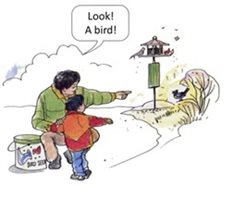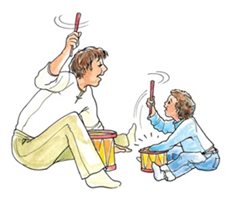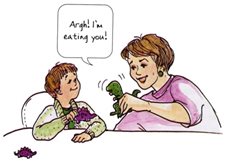Which Children with Autism Develop Better Communication Skills?
By Lauren Lowry
Clinical Staff Writer and Hanen SLP

| “If you’ve met one person with autism, you’ve met one person with autism”
Dr. Stephen Shore
|
The quote above highlights the fact that people with autism are individuals, and that there is a lot of variation in their interests and abilities. You can’t assume that one person’s experience will be the same as another’s, when it comes to autism.
By pinpointing these key skills, therapy can focus on these areas to give children the best possible “kick start” to their communication development.
This variability is also true when it comes to communication. It hasn’t always been easy to predict which children will become better communicators and which experiences and skills will lead to better outcomes. But recently, researchers have been trying to figure out which skills in early childhood are connected to better communication abilities later on. By pinpointing these key skills, therapy can focus on these areas to give children the best possible “kick start” to their communication development.
Key Skills That Predict Better Communication Outcomes:
Joint Attention, Imitation and Toy Play
Research has shown that children who have better abilities with these three skills in early childhood have better communication skills as older children [1,2]:
 |
Joint attention
Joint attention involves sharing a common focus with someone by looking at and sending messages about the same object or event. For example, in the picture, the little boy and his father are sharing a common focus on the bird in the distance. Children need to learn to:
- respond to joint attention, which means noticing something that someone is drawing their attention to (like the boy in the picture) and;
- initiate joint attention, which means drawing someone else’s attention to something of interest.
|
 |
Imitation
Imitation is the ability to copy other people’s sounds, facial movements, body movements, and actions with objects.
|
 |
Toy play
There are two types of toy play that are connected to communication development ─ “functional toy play” and “pretend play”:
- Functional play involves using toys in expected ways, such as putting a marble onto a ramp so it runs down to the bottom, pushing a car, or putting a puzzle piece in a puzzle.
- Pretend play involves imagining with toys, such as pretending to feed a doll, putting gas in a toy car, or cooking with toy food in a toy kitchen.
|
Difficulties with joint attention, imitation and toy play can be seen even in very young children with autism between ages 9-18 months. This is important because, if difficulties in these areas are identified at a very young age, we can focus on them in intervention as early as possible to promote communication development.
How Are Joint Attention, Imitation and Toy Play Connected to Communication?
Researchers suggest that these three skills may be key to the development of communication for the following reasons [1,2]:
- Joint attention helps children learn words – Being able to share a common focus with someone (joint attention) provides young children with opportunities to hear their parents use words about the object/event right at the time that they are paying attention to that object/event. In this way, children learn words for familiar things and learn that other people can provide information about their world.
- Imitation helps children notice what others are doing, interact with them, and copy what they do – Young children learn to connect with their parents early on (well before they learn to talk) by looking at them and copying their smiles, sounds, and actions. These early social interactions are like conversations without words, with parent and child taking turns copying each other and having fun while doing so. These early “conversations” give parents and infants wonderful opportunities to connect and enjoy each other. At the same time, the children are noticing others’ behaviour and copying it, making it possible for them to learn many skills, including how to play and talk.
- Toy play gives parents opportunities to talk about the child’s interests and to encourage social interaction – Parents’ involvement in their child’s play with toys gives him many opportunities to learn. When they interact with their child, they make it possible for him to learn all about objects and what can be done with them. They also talk about the things that the child is doing with the toy or is interested in, helping him learn to communicate.
- Pretend play helps children learn to use symbols – When children learn to pretend with toys, they develop “symbolic thinking”, which means they can use one thing to represent something else (i.e., the toy banana represents a real banana or a block represents a phone). Symbolic thinking is needed for communication because our words are really symbols – they provide us with an efficient way of representing our ideas. In addition, so many ideas can be expressed during pretend play, including themes that don’t occur in everyday life (like castles or pirates). This means that the more play skills the child has, the more opportunities he has to hear and use a variety of words.
Helping Young Children Develop Joint Attention, Imitation, and Toy Play
By helping young children with autism develop joint attention, imitation and toy play skills, we can set the stage for communication development. All three of these skills involve
interacting with people and noticing what they are doing and looking at. You can help your child do this by:
- Observing your child’s interests – The easiest way to share a common focus with your child is to look at and talk about what he is interested in at the moment. Even if your child’s interest is unusual, lean in close, look at whatever he is looking at and talk about it. In other words, turn it into an interaction.
- Being at your child’s physical level – It’s impossible to share a common focus if you both can’t see the same things! You need to be at your child’s physical level so that you are both looking at and paying attention to the same thing. This might mean sitting on the floor or crouching down so you can see what your child is paying attention to and he can look directly at you.
- Imitating what your child is doing – A great way to get an interaction started and make sure you and your child are both paying attention to the same thing is to copy what your child is doing. This helps him notice you and what you are doing. Once you have your child’s attention, you can try to do something a bit different, but related to what he is already doing to see if he will copy you back! For example, if he is pushing a car back and forth, you can copy him by doing the same thing with your own car. Then, once he’s noticed what you are doing, do something new with the car, like crash it into another car or drive it down a ramp. Then wait to see what he does next and keep the game of copycat going.
It is very important to follow your child’s lead by noticing his interests and copying what he is doing because this allows him to continue to pay attention to what he’s most interested in. Children with autism have difficulty shifting their attention away from their own interests and towards what other people are paying attention to. Therefore, by interacting around whatever is of interest to your child, you are not making him shift his attention. In addition, he is more likely to notice what you are doing. In this way, you have set the stage for building joint attention, imitation, and play skills.
Specific information and strategies regarding how to teach joint attention, imitation and toy play can be found in the following resources:
- More Than Words® [3] – Joint attention, imitation, and toy play are key skills targeted during More Than Words® – The Hanen Program® for Parents of Children with Autism Spectrum Disorder. Parents learn how to use their child’s interests and follow their child’s lead in order to:
- draw their child’s attention to items during everyday life, as well as encourage their child to draw their parents’ attention to interesting items.
- imitate their child to get an interaction started, and then to encourage their child to imitate them back
- identify their child’s stage of toy play and to encourage either functional or pretend play with toys that are interesting to the child
The development of joint attention, imitation, and toy play skills are essential for young children with autism as these skills set the stage for later interaction and communication development. By targeting these important skills early on with young children, we can stack the odds in their favour for better communication outcomes.
References
1. Toth, K., Munson, J., Meltzoff, A. N. & Dawson, G. (2006). Early Predictors of Communication Development in Young Children with Autism Spectrum Disorder: Joint Attention, Imitation, and Toy Play. Journal of Autism and Developmental Disorders, 36, 993–1005.
2. Poon, K. K., Watson, L. R., Baranek, G. T. & Poe, M. D. (2012). To What Extent Do Joint Attention, Imitation, and Object Play Behaviors in Infancy Predict Later Communication and Intellectual Functioning in ASD? Journal of Autism and Developmental Disorders, 42, 1064–1074.
3. Sussman, F. (2012). More Than Words® – A Parent’s Guide to Building Interaction and Language Skills for Children with Autism Spectrum Disorder or Social Communication Difficulties (2nd ed.). Hanen Early Language Program: Toronto, Ontario.
4. Sussman, F. & Weitzman, E. (2014). Take Out the Toys: Building Early Toy Play for Children with Autism Spectrum Disorder and Other Social Communication Challenges. Toronto, ON: The Hanen Centre.